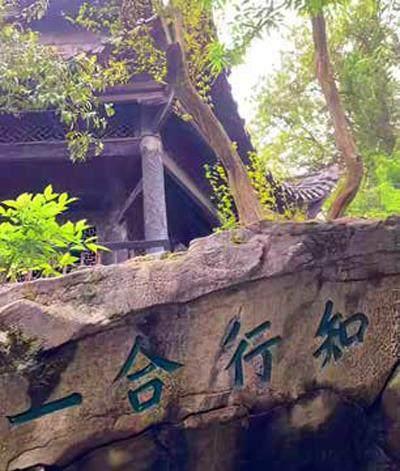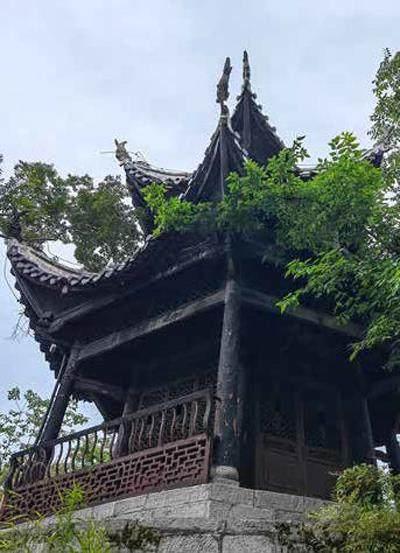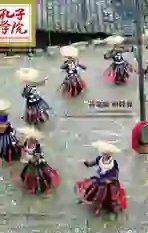修文阳明洞
2023-11-18赵永刚
赵永刚




陽明洞位于贵州省修文县东北的龙岗山上,因明代著名哲学家、教育家、政治家和军事家王守仁(字阳明,世称“阳明先生”)被贬至此、在此悟道而名传后世。
正德三年(1508)春天,因反对宦官刘瑾专权,王阳明被贬。经过数月长途跋涉,他终于抵达贬谪之地——贵州龙场(今修文县)。当时的龙场驿没有官台,王阳明刚来的时候无处容身,于是简单搭了一间草屋居住。不久之后,他在龙岗半山腰发现了一处天然石洞。石洞非常宽阔,面积约90平方米,内有天然形成的石凳、石床,旁边还有生活水源。石洞显然比草屋更遮风蔽雨,王阳明就移居到洞中,并将此洞更名为“阳明小洞天”。后人为了纪念王阳明,就将此洞称为“阳明洞”。
王阳明在洞中克服了常人难以忍受的艰苦,战胜了极端压抑寂寞的心理危机。更难能可贵的是,在洞中生活的这段时间,王阳明对于儒家哲学有了全新的认识。他认为道德原理根植于道德主体内心,不在外物之上,冲破了“理学”的传统观念。王阳明还彻悟到,道德认知与道德实践是紧密联系在一起的,即“知行合一”。王阳明这两个重要的哲学突破,就是著名的“龙场悟道”,它们改变了中国哲学的发展方向,其影响力也波及韩国、日本,对世界哲学也有一定的影响。阳明洞也因此成为重要的文化遗产,历代来此参访者络绎不绝。明代贵州土司安国亨在阳明洞口上方镑刻“阳明先生遗爱处”,以此表达对王阳明的感念之情。明代学者罗汝芳、日本明治时期学者高山公通等先后来此参访,并留有石刻文字。阳明洞口有两棵柏树,相传为王阳明亲手栽种,固王阳明在明代万历时期被封为王文成公,后世称之为“文成柏”。
阳明洞山体左上方是何陋轩。王阳明高尚的人格赢得了龙场百姓的衷心拥护,他们发现阳明洞过于潮湿,就自发组织修建何陋轩作为王阳明的居住之所。何陋轩的名字取自《论语·子罕》:“君子居之,何陋之有?”
出阳明洞口左转,沿山路拾级盘旋而上,就是王文成公祠,祠堂前身是龙岗书院。龙岗书院是龙场百姓为王阳明修建的讲学之所,是王阳明传播心学思想最早的书院,可以说是阳明心学的诞生之所,王阳明最早的系统教育理念也奠基于此。王阳明去世之后,明朝嘉靖三十年(1551),贵州监察御史赵锦将其改为“王文成公祠”。祠堂是一座四合院建筑,由祠堂正殿、左右两厢房与元气亭组成。正殿供奉王阳明朝服塑像,历代祭祀王阳明的活动经常在此举行。值得一提的是,祠内右厢房曾被蒋介石用来关押爱国将领张学良。张学良与夫人赵一荻在此度过了三年的软禁生活。软禁期间,张学良阅读了很多王阳明的著作,由此对阳明心学以及明代历史产生了浓厚兴趣。
王文成公祠的对面是君子亭。亭子周围有很多竹子,王阳明认为竹子具有君子的多种品格,故称此亭为“君子亭”。君子亭下面是宾阳堂,属于当年龙岗书院建筑群,是书院接待宾客的地方。
近年来,贵州省政府将阳明洞古建筑群扩建成中国阳明文化园。园区占地3 500余亩,包括“王阳明纪念馆”与“阳明广场”等。矗立在广场正中的王阳明铜像高15.08米,寓意王阳明来到阳明洞的时间是公元1508年。虽然时间已经过去了500多年,阳明心学的影响却从未中断。当地政府每年都举办“阳明学术文化活动”,越来越多的世界友人来此参访游学,阳明洞也成为中国阳明心学的文化地标。
The Yangming Cave in Xiuwen County
Located in the Longgang Mountain in XiuwenCounty, Guizhou Province, the Yangming Cave isnamed a er the renowned Ming-dynasty philosopher,educator, statesman and military leader Wang Shouren(art name Yangming, also known as Master Yangming).Having gained his epiphany in this cave a er being demoted,Wang Yangming has given the cave perpetualfame.
In the spring of the third year of Zhengde (1508),Wang was demoted for opposing the hegemony of theeunuch Liu Jin in court. After months of wearying travel,Wang finally arrivedat the place he was demotedto, Longchang(now Xiuwen County)in Guizhou Province,which didn’t even havean official residence atthe time. So Wang hadto build a makeshiftthatched cottage as atemporary dwelling.Soon, he found a naturalcave halfway up theLonggang Mountainwith a spacious area ofabout 90 square meters.With naturally formedstone stools and stonebeds inside the caveand drinking water resources nearby, the cave proveda far better shelter than the cottage. Wang moved intothe cave and named it “Yangming Xiaodongtian” (theMiniature Cave-Heaven of Yangming). Later generationscalled the cave “Yangming Cave” to commemorateWang.
Wang endured an exceptionally dreary life in thecave, and it was here that he overcame his mental crisiscaused by extreme suppression and isolation. Moreover,it was here that Wang reconceptualized Confucianphilosophy, claiming that moral principles originatefrom the mind of the subject instead of from externalobjects. This was a rebel against the traditional Schoolof Principle in Neo-Confucianism. Wang also cameto the conclusion that one’s moral knowledge is insep-arable from one’s moral actions, hence the maxim “the unity of knowledgeand action”. These two philosophical breakthroughs constitute thefamous “epiphany of Longchang”, which has changed the direction ofChinese traditional philosophy and in uenced Japan and Korea, eventuallyleaving its mark in world philosophy. The Yangming Cave has sincebecome an important cultural site, attracting visitors across history andcultures. An Guoheng, the Ming-dynasty Aboriginal Chief of Guizhouhad it inscribed above the entrance of the cave “Witness to the enduringgrace of Master Yangming” to pay homage to the philosopher. LuoRufang, a scholar of the Ming Dynasty, and Kimimichi Takayama, ascholar of the Meiji Period in Japan, visited this cave and le stone inscriptions.There are two cypress trees at the entrance of the cave whichare said to have been planted by Wang himself. As Wang was canonizedwith the posthumous name Duke Wang of Wencheng in the Wanli periodof the Ming Dynasty, the trees are also called “Duke Wencheng’sCypress”.
To the upper le side of the cave is the Helou Pavilion. Wang’s noble character had won heartfelt support of the Longchang people, so they volunteered to build a dwelling place for him after discoveringthat the Yangming Cave was too damp for living.This became the Helou Pavilion. The name “Helou”comes from the chapter “Zihan” in The Analects: “Wherethe gentleman abides, what shabbiness there is?”
If you come out of the cave and urn le , ascend the winding steps along themountain path and you will nd the Temple of Duke Wang of Wencheng, whoseformer incarnation was the Longgang Academy. Longgang Academy was builtby local people for Wang as a venue for teaching. As the first academy whereWang promoted his School of Mind, Longgang Academy was the birthplace ofthe school and the founding place of Wang’s systematic educational theories.After wang passed away, Zhao Jin, the Investigating Censor of Guizhou turnedthe academy into the temple of Duke Wang of Wangcheng in the thirtieth yearof Jiajing (1551). The temple was a Siheyuan-style courtyard house consisting ofthe main hall in the center, le and right chambers anking it and the Yuanqi Pavilion.The main hall enshrines a statue of Wang in his court dress, and worshipservices to Wang have o en been held here over the ages. It’s worth mentioningthat the western chambers of the temple had once been used by Chiang Kai-shekto put the patriotic general Zhang Xueliang under house arrest. During the threeyears that General Zhang and his wife Zhao Yidi had been con ned in this residence,Zhang read many of Wang’s writings and developed his interest in Wang’s School of Mind and the history of the Ming Dynasty.
Facing the temple is the Junzi Pavilion surrounded bybamboos. Wang believes that bamboos partake of many ofthe noble qualities of the junzi, or the gentleman, consideredto be the embodiment of Confucian ideal, so the pavilion isnamed after Junzi. Below the pavilion is the Binyang GuestHall, which was part of the building complex of the formerLonggang Academy and was used by the academy as a guestreception venue.
In recent years, the Guizhou provincial government hasexpanded the Yangming Cave historic building complex intothe Yangming Cultural Park which covers an area of over3,500 mu (approximately 2,333 square meters). The parkincludes the Wang Yangming Memorial and the YangmingSquare. The bronze statue of Wang standing at the centerof the square reaches a height of 15.08 meters, symbolizingthe year 1508 when Wang rst came to the Yangming Cave.Although five hundred years have passed, the YangmingSchool of Mind continues to influence today’s world. Eachyear, the local government hold academic and cultural eventsfocusing on the Yangming School and more and more visitorsfrom across the world are coming here to learn somethingabout Wang, making the Yangming Cave a cultural landmarkfor the Yangming School of Mind in China.
